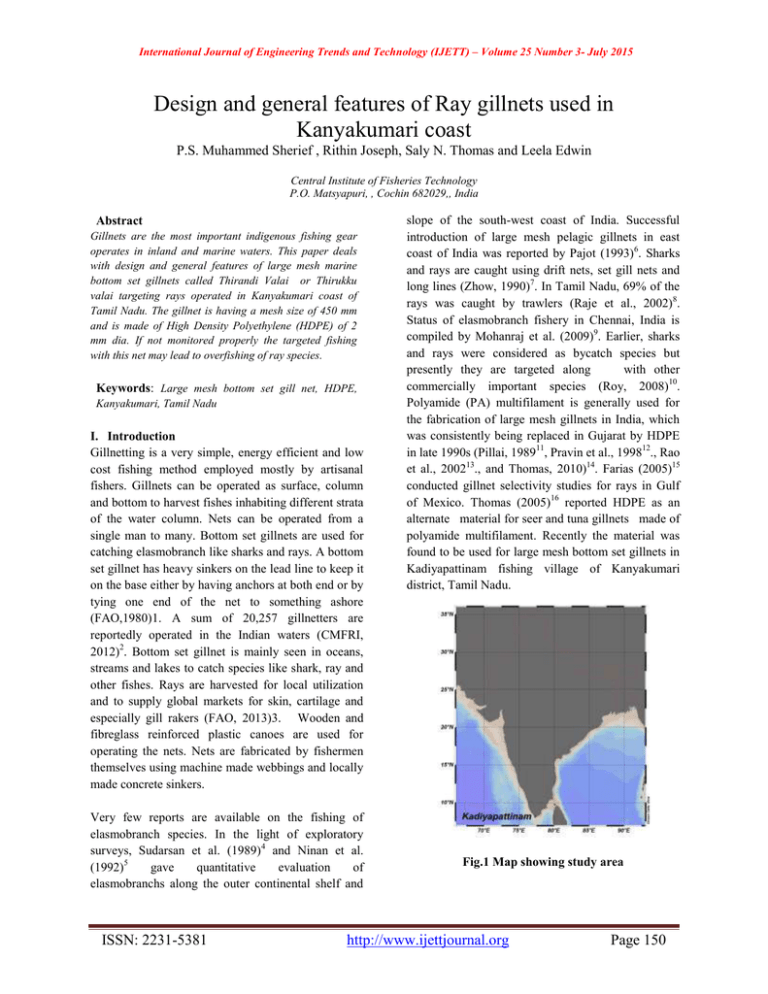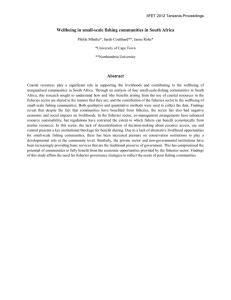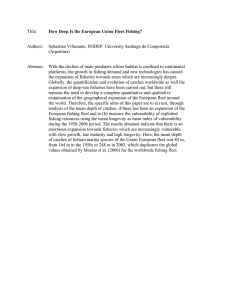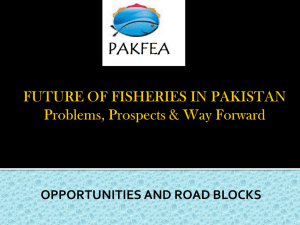Design and general features of Ray gillnets used in Kanyakumari coast Abstract
advertisement

International Journal of Engineering Trends and Technology (IJETT) – Volume 25 Number 3- July 2015 Design and general features of Ray gillnets used in Kanyakumari coast P.S. Muhammed Sherief , Rithin Joseph, Saly N. Thomas and Leela Edwin Central Institute of Fisheries Technology P.O. Matsyapuri, , Cochin 682029,, India Abstract Gillnets are the most important indigenous fishing gear operates in inland and marine waters. This paper deals with design and general features of large mesh marine bottom set gillnets called Thirandi Valai or Thirukku valai targeting rays operated in Kanyakumari coast of Tamil Nadu. The gillnet is having a mesh size of 450 mm and is made of High Density Polyethylene (HDPE) of 2 mm dia. If not monitored properly the targeted fishing with this net may lead to overfishing of ray species. Keywords: Large mesh bottom set gill net, HDPE, Kanyakumari, Tamil Nadu I. Introduction Gillnetting is a very simple, energy efficient and low cost fishing method employed mostly by artisanal fishers. Gillnets can be operated as surface, column and bottom to harvest fishes inhabiting different strata of the water column. Nets can be operated from a single man to many. Bottom set gillnets are used for catching elasmobranch like sharks and rays. A bottom set gillnet has heavy sinkers on the lead line to keep it on the base either by having anchors at both end or by tying one end of the net to something ashore (FAO,1980)1. A sum of 20,257 gillnetters are reportedly operated in the Indian waters (CMFRI, 2012)2. Bottom set gillnet is mainly seen in oceans, streams and lakes to catch species like shark, ray and other fishes. Rays are harvested for local utilization and to supply global markets for skin, cartilage and especially gill rakers (FAO, 2013)3. Wooden and fibreglass reinforced plastic canoes are used for operating the nets. Nets are fabricated by fishermen themselves using machine made webbings and locally made concrete sinkers. Very few reports are available on the fishing of elasmobranch species. In the light of exploratory surveys, Sudarsan et al. (1989)4 and Ninan et al. (1992)5 gave quantitative evaluation of elasmobranchs along the outer continental shelf and ISSN: 2231-5381 slope of the south-west coast of India. Successful introduction of large mesh pelagic gillnets in east coast of India was reported by Pajot (1993) 6. Sharks and rays are caught using drift nets, set gill nets and long lines (Zhow, 1990)7. In Tamil Nadu, 69% of the rays was caught by trawlers (Raje et al., 2002)8. Status of elasmobranch fishery in Chennai, India is compiled by Mohanraj et al. (2009)9. Earlier, sharks and rays were considered as bycatch species but presently they are targeted along with other commercially important species (Roy, 2008)10. Polyamide (PA) multifilament is generally used for the fabrication of large mesh gillnets in India, which was consistently being replaced in Gujarat by HDPE in late 1990s (Pillai, 198911, Pravin et al., 199812., Rao et al., 200213., and Thomas, 2010)14. Farias (2005)15 conducted gillnet selectivity studies for rays in Gulf of Mexico. Thomas (2005)16 reported HDPE as an alternate material for seer and tuna gillnets made of polyamide multifilament. Recently the material was found to be used for large mesh bottom set gillnets in Kadiyapattinam fishing village of Kanyakumari district, Tamil Nadu. Fig.1 Map showing study area http://www.ijettjournal.org Page 150 International Journal of Engineering Trends and Technology (IJETT) – Volume 25 Number 3- July 2015 Gill nets are widely used for marine fishing along the Tamil Nadu coast. There are 46,070 fishing crafts in Tamil Nadu of which 4028 are mechanized gillnetters, 24,942 motorized and 10,436 non-motorized (CMFRI, 2012)2. These crafts operate, gillnets made of PA and HDPE. In few regions of Tamil Nadu, as in Kadiyapattinam fishing village of Kanyakumari, bottom set gillnets targeting sting ray is operated. In Kadiyapattinam fishing village, fishermen mostly do fishing with non-motorized and motorized fishing crafts. Only few reports on using bottom set gillnets targeting ray are available in the country. Presently, protection and management of elasmobranch population is becoming increasingly important on a global perspective. In this context, the design and structural details of large mesh bottom set ray gillnets made of HDPE operated in Kadiyapattinam are examined. II. Materials and method Data on technical details of the net was collected during January 2015 from Kadiyapattinam (Fig.1), fishing village of Kanyakumari district using structured questionnaire covering details of fishing craft and gear. The details were recorded as per Sree Webbing material Krishna & Shenoy (2001)17 and Thomas & Hridayanathan (2002)18. Design details were depicted as per Nedelec (1975)19. III. Results and Discussion Fishing Gear Technical specification of gillnetter and the ray gillnet are given in Table 1. Design of a typical ray gill net is given in Fig. 2. Nets were made up of HDPE multifilament of 2 mm diameter with 450 mm mesh size. The total fleet length of the gillnet was 2000 m. Similar sized ray gillnets were used by fishers at Central Java (Dharmad and Fahmi, 2014)20 and Malabar region of Kerala coast (Manojkumar et al., 2012)21. The depth of the gillnet was 20 meshes and each piece of net contained 650 meshes in length. The nets were hung to head rope of 4 mm diameter and square shaped concrete sinkers (120x90x25 mm) were attached to the foot rope. As indicated by Chaidee et al. (2007)22 sinkers in the large mesh gillnet help the net expand fully while in operation. The hanging coefficient of the net was 0.51. To enable bottom setting, nets were rigged without floats. On either side of the net thermocol pieces (300x220 mm) were used as buoys. Table. 1 Technical specification of ray gillnet systems HDPE Mesh size (mm) 450 Twine type Twisted monofilament Twine specifications/Diameter (mm) 2 mm (10x3) Colour of the webbing Dark blue Horizontal hanging coefficient (El) 0.51 Hung length (m)/ Panel 150 Hung depth (m) 2.52 Head rope material and diameter (mm) Polypropylene, 4 Foot rope material and diameter (mm) Polypropylene, 4 Sinker material and size (mm) Cement, 120x90x25 Sinker weight (g) ῀ 500 ISSN: 2231-5381 http://www.ijettjournal.org Page 151 International Journal of Engineering Trends and Technology (IJETT) – Volume 25 Number 3- July 2015 Total fleet length (m) 2000-3000 Depth of operation (m) 20-30 Fishing craft Wooden / FRP Fishing craft LOA (m) 12 Mode of propulsion Motorized (10 Hp) and non motorized Fishing Craft The nets were operated from motorized wooden/FRP gillnetter (Fig.3) of 12-18 m LOA fitted with 10 hp engine. Previously the net was operated from catamarans till the introduction of outboard engine fitted country craft along Kanyakumari district in 1981(Pillai and Menon, 2000)23.The depth of operation ranged from 20-30 m. Electronic instrument like Global Positioning System (GPS) was used to locate the fishing site. Nets were set at the ISSN: 2231-5381 bottom using anchor and were soaked for 4-6 h. For finding the net’s position during the night, indicator flag lights were attached to both ends of the net. Setting and hauling of the net was done manually without any mechanical hauling devices. Sardine oil is applied to the fishing craft twice a year as a preservative treatment and marine grade paint is used for FRP craft. http://www.ijettjournal.org Page 152 International Journal of Engineering Trends and Technology (IJETT) – Volume 25 Number 3- July 2015 Fig.2 Design of a typical botom set ray gillnet operated in Kanyakumari ISSN: 2231-5381 http://www.ijettjournal.org Page 153 International Journal of Engineering Trends and Technology (IJETT) – Volume 25 Number 3- July 2015 Fig.3 Gillnetters Fig.4 Stacked in bundles Fig.5 Gillnets kept ashore after fishing Fig.6 Temporary sheds for storing gillnets Operational Details The nets are operated through the whole year and the peak fishing season was June – September (MSSRF, 1997)24 starting from the southwest monsoon. In November, on account of unfavorable climate conditions, the mechanized gillnet operation gets suspended and fisherman operate ray gillnets from non motorized and motorized boats. Normally, fishing is carried out from Monday to Saturday in a week. After every fishing operation, fishers keep the net onboard. Every Saturday after completion of a week’s operation the net is cleaned, made in to bundles (Fig.4 & ) and kept small temporary sheds constructed near shore (Fig.5 Species composition Various sizes of sting rays and eagle rays are caught by the ray gillnet. The ray species caught are Gymnura macrura,G. poecilura, Dasyatis uarnak, D. bleekeri, D. sephen, Aetobatus narinari and Mobula sp . The caudal spine of the sting rays gets entangled in the net and while the fish struggle to escape the ISSN: 2231-5381 whole fish gets entangled in the net. Based on the reports from the fishermen, rays each weighing 10-50 kg is caught. Besides, marine turtles that swim close to the ocean floor and the group of endangered species e.g. sharks, dolphins, dugong, etc., were occasionally caught as incidental catch in these nets. IV. Conclusion A study on the attitude of the fishing communities around Kanyakumari coast towards sea turtle conservation ought to be taken up with a specific goal as to perceive the viewpoints of the fishers. Presently no regulation concerning the elasmobranch fisheries exists under the Department of Fisheries or Forest Act. So, for proper management of those species which are under threat or are critically endangered like sharks and rays under the IUCN Red List (2000), clear guidelines are to be formulated. http://www.ijettjournal.org Page 154 International Journal of Engineering Trends and Technology (IJETT) – Volume 25 Number 3- July 2015 The study shall then be related to the collection of basic Information aiming for the awareness building of fisheries researchers on fishing gear technology. Acknowledgment The authors gratefully acknowledge the support from the National Agricultural Science Fund (NASF) for funding this study. They also thankful Dr. C. N. Ravishankar, Director,ICAR-CIFT for the facilities provided for the study. Help and technical assistance from Shri.P.S Nobi, Technical officer, CIFT Cochin is greatly acknowledged. 13. 14. 15. 16. References 1. FAO (1980). Fishing with bottom gillnets. FAO Training Series - No.3, 39 pg 2. CMFRI (2012) Marine fisheries census 2010 Part-I India, Department of Animal Husbandry, Dairying & Fisheries and Central Marine Fisheries Research Institute, Cochin, 98 pp 3. FAO, (2013b). Convention on International trade in endangered species of wild fauna and flora. Sixteenth meeting of the Conference of the Parties. Bangkok (Thailand), 3‐15 March 2013. 4. Sudarsan, D., Sivaprakasan, T. E., Somavanshi, V. S. John, M. E., Nair, K. N. V. and Antony Joseph 1989. An appraisal of the marine fishery resources of the Indian Exclusive Economic Zone, Bull. Fish. Sur. India, 18: 1-82 5. Ninan, T. V., Sivaji, V., Jagannadh, N. and Ramalingam, L, Observations on demersal resources survey between lat 7°N and 11°N along south-west coast, Wadge Bank and Gulf of Mannar during 1988-1990, Bull. Fish. Sur. India, 24: 1992 14-40. 6. Pajot, G. Large pelagic fishing in India,BOBP News No. 51, 1993, 18-20 7. Zhow, K. and X. Wag, 1990. Brief review of passive fishing gears and incidental catches of small Cetaceans in Chinese waters. Document presented to the International whaling commission workshop in mortality of cetaceans in passive fishing nets and traps. La. Jolla, California. October, 1990(SC/090/21)13.pp. 8. Raje, S.G., Grace Mathew, K.K.Joshi, Rekha J. Nair, G.Mohanraj, M. Srinath, S. Gomathy and N.Rudramurthy, Elasmobranch fisheries of India–An Appraisal. (CMFRI Special Publication) 2002 71:76. 9. Mohanraj, G. Rajapackiam, S. Mohan, S. Hameed Batcha and Gomathy S, Status of Elasmobranchs Fishery in Chennai, India. Asian Fisheries Science 22 (2009): 607-615 10. Roy, B.J. 2008, Shark Fisheries Exploitation Trade and Conservation of Bangladesh, Presented in the Convention on Migratory Shark (CMS) 2nd meeting Held on 6-8 December, 2008 at FAO Head Quarter Rome, Italy. 11. Pillai, N.S., Boopendranath, M.R. and Kunjipalu, K.K, Studies on the Suitability of HDPE Material for Gill Nets, Fish. Technol., 26: (1989) 1-3 12. Pravin, P., Remesan, M.P. and George Mathai,P, Gill net fishing in Gujarat. In: Advances and Priorities in Fisheries Technology, edited by Balachandran, K.K.,Iyer,T.S.G., ISSN: 2231-5381 17. 18. 19. 20. 21. 22. 23. 24. Madhavan, P., Joseph, J., Perigreen, P.A., Raghunath, M.R., & Varghese, M.D.,Eds, (Society of Fisheries Technologists (India), Cochin) 1998, 170-176 Rao, S. V. S, Rajeshwari, G. and Raghuprakash, R. (2002) Studies on the gillnets of Andhra Pradesh, Fish.Technol. 39: 15-19 Thomas, S.N.,(2010). Gilinet Fishing in India,In: Coastal Fishery Resources of India: Conservation and Sustainable Utilisation (Meenakumari, B., Boopendranath, M.R., Edwin, L., Sankar, T.V., Gopal, N. and Ninan, G., Eds.),p 314-326 , Society of Fisheries Technologists (India), Cochin Fernando Márquez Farias J, Gillnet Mesh Selectivity for the Shovelnose Guitarfish (Rhinobatos productus) from FisheryDependent Data in the Artisanal Ray Fishery of the Gulf of California, Mexico. J. Northw. Atl. Fish. Sci., Vol. 35: (2005). 443–452 Thomas, S.N., Meenakumari, B., Pravin, P. and George Mathai, P. (2005) Gill nets in Marine Fisheries of India, 45 p. Monograph, ATIC, CIFT, Cochin. Sreekrishna, Y. and Shenoy, L, Fishing Gear and Craft Technology, (Directorate of Information and Publication of Agriculture. Indian Council of Agricultural Research, New Delhi), 2001, 242 Thomas, S.N. and Hridayanathan, C. (2002) Substitution of polyamide multifilament by polyethylene twisted monofilament in large mesh gill nets Fish Technol. 39 pp 100-106. Nedelec, C. FAO Catalogue of Small Scale Fishing Gear,(Fishing News (Books) Ltd., Farnham, Surrey, England), 1975, 191 Dharmad and Fahmi (2014). Biological Aspects, Stock and Conservation Status of Giant Oceanic Manta Ray, Manta birostris in the Indian Ocean. PROCEEDINGS of the Design Symposium on Conservation of Ecosystem (The 13th SEASTAR2000 workshop) (2014), 2: 1-8 Manojkumar, P. P. Zacharia P. U. and. Pavithran P. P, Fishery of elasmobranchs with some observations on the biology and stock assessment of Carcharhinus limbatus (P. Muller & Henle, 1839) exploited along Malabar Coast. Indian J. Fish., 59(4): (2012) 35-41 Chaidee, P., Darumas, N., Chamasont, O., Sada, M. N., Jayasinghe, R. P. K., Chinthaka, K. S. D., Sein A.W, Nalla, J and Thapanand-Chaidee, T . Marine Resource Surveys by Drift Gill Net in the Bay of Bengal. 2007 Pillai, P K Mahadevan and Balakrishnan, G and Philipose,Varughese and Rajendran, V (2000) Appraisal on the marine fishing craft and gear of the Indian coast. In: Marine Fisheries Research and Management. Pillai, V N and Menon, N G,(eds.) CMFRI; Kochi, Kochi, pp. 190-221 MSSRF, Season based fish calendar –(MSSRFINCOIS).1997 http://www.ijettjournal.org Page 155




